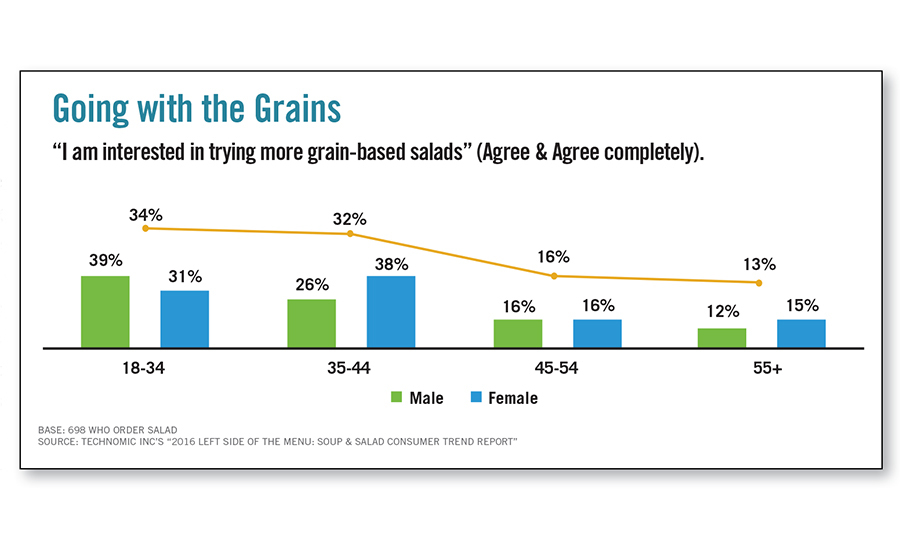Salad consumption is trending up slightly, aligning with consumers’ increasing desire to eat well. Data from Technomic’s “2016 Left Side of the Menu: Soup & Salad Consumer Trend Report” provides insights into the preferences of consumers when it comes to salads, which are traditionally viewed as lighter, better-for-you fare.
Salad is positioned as a popular appetizer and side, but with the migration of vegetable-focused items to the center of the plate, younger consumers drive demand for more filling, entrée-worthy salads.
Promoting salads as filling and flavorful would appeal to younger consumers—who are especially likely to eat these foods as an entrée. Warmed salads and a choice of protein, along with other satiating toppings like nuts and beans, can position salad as an entrée while providing consumers their desired control over the foodservice experience.
Adding more starches, grains, lean meats, beans, nuts and servings of vegetables to salad could maintain its healthfulness, while increasing heartiness and value. More than one-third of 18-34-year-old consumers say they are interested in trying more grain-based salads, with ingredients such as quinoa, wheat berry and farro.
The call for more of these ingredients could be attributed to younger consumers’ greater interest in vegetarian diets. Many of these grains also are naturally gluten-free.
Some recent menu additions that pack in protein, grains and vegetables include the Liv Med salad at Zoës Kitchen, with zucchini and squash ribbons, lupins, spinach, farro, cherry tomatoes and Parmesan in a Calabrian-pepper dressing; and the Power Kale Salad, a limited-time offering at fast-casual chain Spicy Pickle that features kale, bulgur, chickpeas, red onions, feta cheese, apples, red peppers and lemon-vinaigrette dressing.
Grain-based salads with quinoa, farro and rice are trending now, but expect to see these items evolve with the appearance of sprouted, ancient and new, little-known superfood grains—such as teff, freekeh, kamut and fonio—on top chain restaurant menus.
Many of these grains originate in other parts of the world, offering unfamiliar items in an approachable format. Other ethnic- and globally inspired ingredients in salads also entice customers looking for familiar foods with unique twists. Some of the fastest growing ingredients in entrée salads on top full-service restaurant chain menus include cilantro (a staple in Mexican dishes), carrot (with its popularity in Southeast Asian recipes) and arugula (a premium, leafy green of Mediterranean origin).
Limited-service chains also are boosting salads with ethnic ingredients: In March, Chop’t Creative Salad Company launched a line of limited-time, South American-inspired salads, including the Spicy Peruvian Salad with aji amarillo chicken or grass-fed steak, spicy peppers, Peruvian corn nuts, roasted aji amarillo potatoes, charred red onions, and a romaine and radicchio blend.
Earlier this year, Zippy’s Restaurants debuted a Korean Fried Tofu Salad made with panko-crusted fried tofu tossed in Korean sauce, tomato, cucumber, green onions, aquaponic greens and house-made dressing.
As dayparts and mealparts blur, interest is growing in salad for snacks and even for breakfast. Salad’s healthfulness and flexibility make it a suitable option for many occasions. Smaller portions of nutrient-rich salads—currently cropping up at trendy, health-focused independents and in fresh vending machines—may emerge on top chains’ snack menus. For example, Chicago-based fast-casual chain Hannah’s Bretzel this year added a grain bowl to its morning menu; the Ancient Grain Bowl is made with organic freekeh, organic apples, golden raisins, toasted pumpkin seeds, cinnamon and organic raspberry preserves.
As consumers continue to look for more healthful items, demand for filling and flavorful salads will only grow. Ethnic-inspired ingredients in salads can interest consumers with innovation in an approachable format. These offerings can add value and appeal to customers looking for tasty, yet healthy foods.
Originally appeared in the May, 2016 issue of Prepared Foods as Salad Appeal.
